Asus Nexus 7 Wireless Charging
Tech —
Look Ma, no wires! A mini-review of Google's Nexus Wireless Charger
This attractive accessory trades efficiency for convenience.

The Nexus wireless charger.
Andrew Cunningham
Wireless charging is inappreciably a ubiquitous feature in smartphones and tablets at this betoken. It'due south frequently optional—phones from sure carriers volition take it, or yous'll be able to add it to a phone using a special charging instance. But if yous choice a phone at random off the shelf, chances are good that it won't support wireless charging out of the box.
Google's most recent Nexus devices, on the other hand, accept all included born support for the characteristic—the Nexus four, Nexus five, and 2013 Nexus 7 all support wireless charging. While whatever charging pad that supports the Qi (pronounced "chee") standard will work with them, as of concluding calendar week Google will sell you its own Nexus-branded charger to lucifer. This is actually the second Nexus charger that Google has made, after the now-discontinued (and somewhat problematic) Nexus 4 wireless charger. Google sent the states one of the new chargers, and we put it through its paces to see if information technology's worth the $50.
Unboxing
Contempo Nexus phones and tablets have come in well thought out, understated blue boxes, and the Nexus wireless charger follows the tendency. Elevator the lid off the box and the charger volition exist sitting right at that place, staring you in the face.
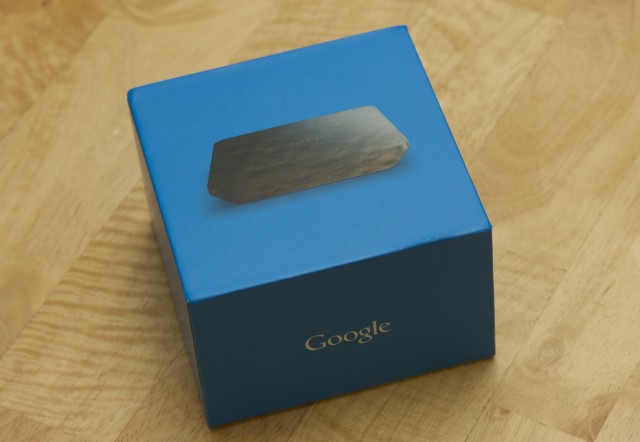
Enlarge / The square blue box that the charger ships in matches the packaging for the Nexus seven and Nexus five.
Andrew Cunningham
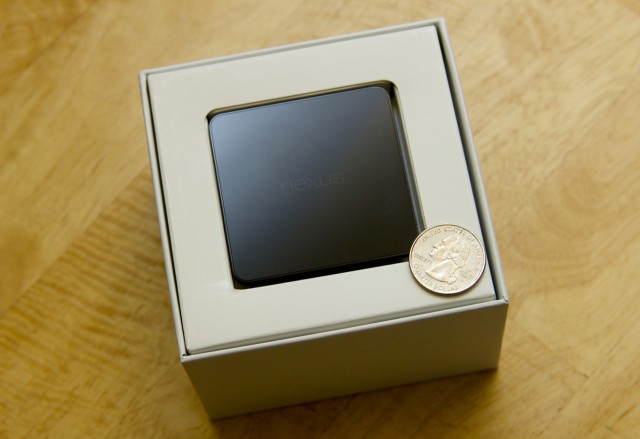
Enlarge / The charger in its box (with a quarter used for scale).
Andrew Cunningham
The charger itself is a surprisingly small foursquare that'due south 2.36 inches on each side and one-half an inch thick, only it's pretty dense—it weighs three.7 ounces, non all that much less than the Nexus 5's 4.59 ounces. The sleeky black top is unadorned salve for a faint Nexus logo in the center, and the sides are a blank matte plastic except for the side with the micro USB port embedded in it.
On the underside, Google has applied some sticky merely not-quite-agglutinative material that plants the charger firmly to whatsoever surface yous'd like, only information technology doesn't leave a rest when you lot pry it off. This material is not quite equally sticky as tape, but it'due south grippy enough that information technology could hang out on the wall of my office for 15 or 20 seconds earlier falling on the floor (whoops). It should easily keep the charger from sliding effectually on your desk or bedside tabular array, but if you move information technology around a lot you lot'll need to clean the dust and dust off it to continue it gummy.
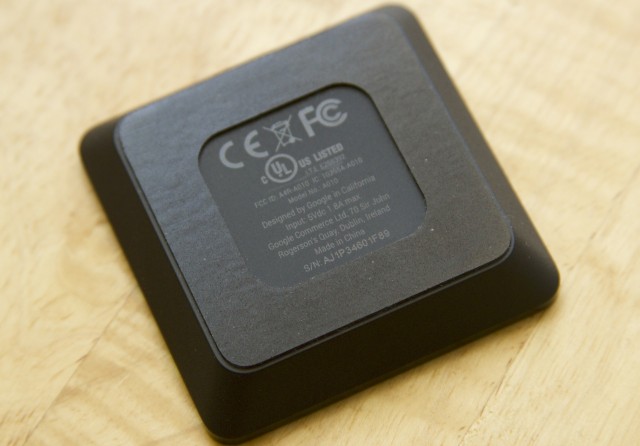
Enlarge / Always be trolling: the charger has "Designed past Google in California" inscribed on the lesser, the aforementioned phrasing commonly used by a certain other California-based tech company.
Andrew Cunningham
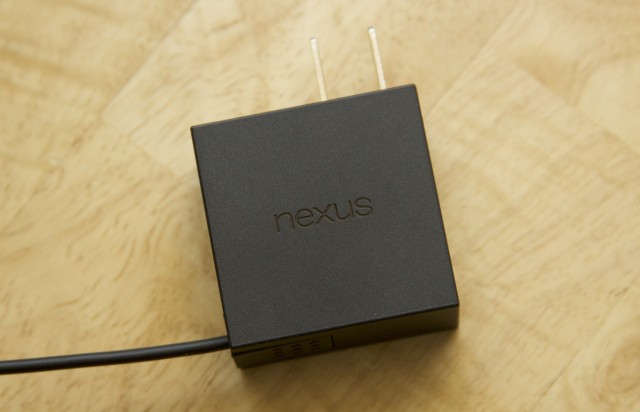
Overstate / The ability adapter is pretty nondescript, aside from the Nexus logo…
Andrew Cunningham
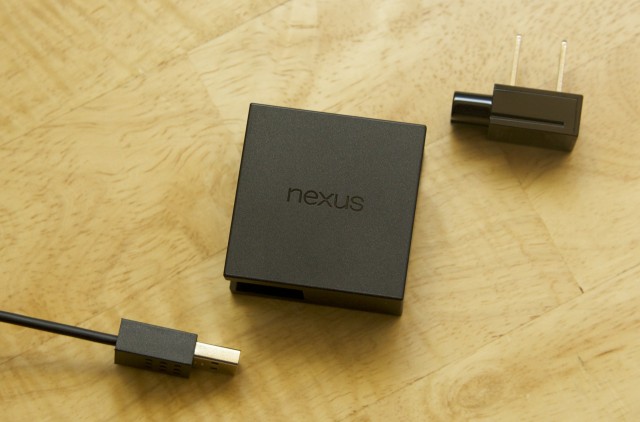
Enlarge / …and the sort-of-cool, LEGO-ish fashion that the plug and the USB cablevision interlock with the rest of the adapter.
Andrew Cunningham
You won't find a mention of the Qi standard anywhere on Google'south product page, only that appears to be what the Nexus charger is using. Information technology's listed as being compatible with the Nexus four, Nexus v, and the 2013 Nexus 7, simply it should also work fine with other Qi-enabled phones (or phones with Qi-compatible charging cases).
Once you've stuck the charger where you lot want it, you just demand to set your telephone or tablet on superlative of it to get-go charging. Magnets volition pull the device into place and keep it in that location, so the device isn't in any danger of slipping off the charger or moving also much if you need to poke at information technology while it's charging. Centering the tablet on the charger can be a trivial tricky, but all three Nexus devices brand a distinctive notification sound when charging wirelessly to tell y'all when you've done it correctly.

Enlarge / Your device can tell y'all information technology's charging wirelessly if y'all want to check.
Andrew Cunningham
On the whole, the pattern of the charger is better idea out than the old Nexus 4 wireless charger. That device had an angled face (which made it difficult to impossible to utilise with annihilation larger than a telephone) and used the same non quite adhesive material to hold the slippery Nexus phone to the charger. As we've noted, this material picks upward grit and other detritus easily, and the dirtier it is the worse it is at sticking to things. The Nexus 4 charger had the more distinctive pattern, only the new charger is definitely more functional.
Power draw and charging speeds

Enlarge / The Nexus 5, charging away.
Andrew Cunningham
This was my own offset foray into wireless charging, so I was interested in seeing how much ability the charger used compared to a standard wired charger plus how this afflicted charging speeds. Using an ever handy Kill-A-Watt meter, I measured power draw at the wall for both the wireless charger and a standard micro USB charger (these figures are for the adapter that shipped with the 2013 Nexus 7, but the figures for the i that comes with the Nexus v were well-nigh the aforementioned). These figures were each taken when the phone'southward battery was mostly empty and with the screens turned off (the numbers will by and large go up when the screen is on and the device is in active apply, and they'll fall every bit you about the end of a accuse bike).
| Device | Power draw (micro USB) | Ability draw (wireless charger) |
|---|---|---|
| Nexus 5 | half dozen.6 Watts | half dozen.0 Watts |
| Nexus 7 (2013) | seven.5 Watts | 6.1 Watts |
The Nexus five and Nexus 7 will both draw more power through a micro USB charger than the wireless charger, which is par for the course—wireless charging usually isn't as fast as charging through a cable. These differences in power draw are reflected in charge times. The Nexus vii takes nigh two hours and 56 minutes to accuse using its power adapter, but six hours and six minutes to charge using the wireless charger. The wireless charger draws nearly 25 pct less ability, simply information technology takes 100 pct more time to charge the tablet. Keep in mind that the convenience of wireless charging besides takes longer and is less efficient.
Wireless charging is still a nice feature—it's a good box to check, but its exclusion wouldn't keep us away from an otherwise attractive telephone or tablet. If your telephone does support Qi, and you're in the market for a dainty charger, you could do worse than Google's. Unlike its first try, the new Nexus Wireless Charger is unobtrusive, attractive, and functional. Information technology'due south a little pricey at $50 (compared both to other charging pads and to the adapter that came with your phone), but it gets the task done.
Source: https://arstechnica.com/gadgets/2013/11/look-ma-no-wires-a-mini-review-of-googles-nexus-wireless-charger/

0 Response to "Asus Nexus 7 Wireless Charging"
Post a Comment